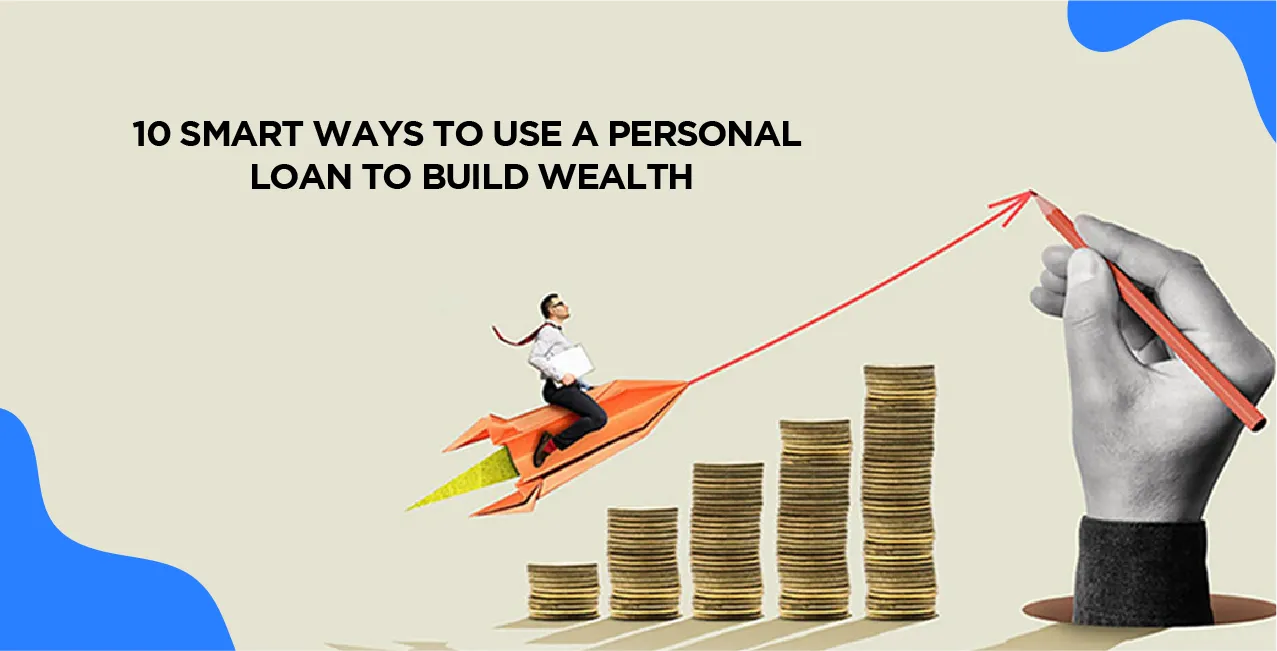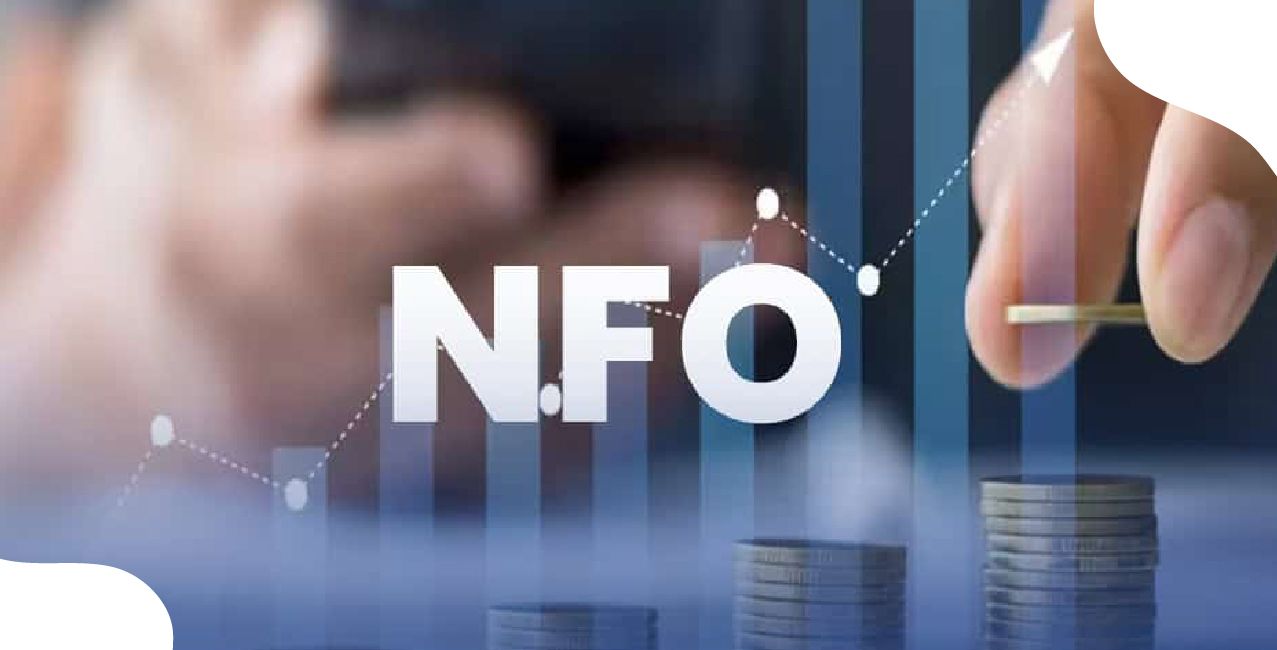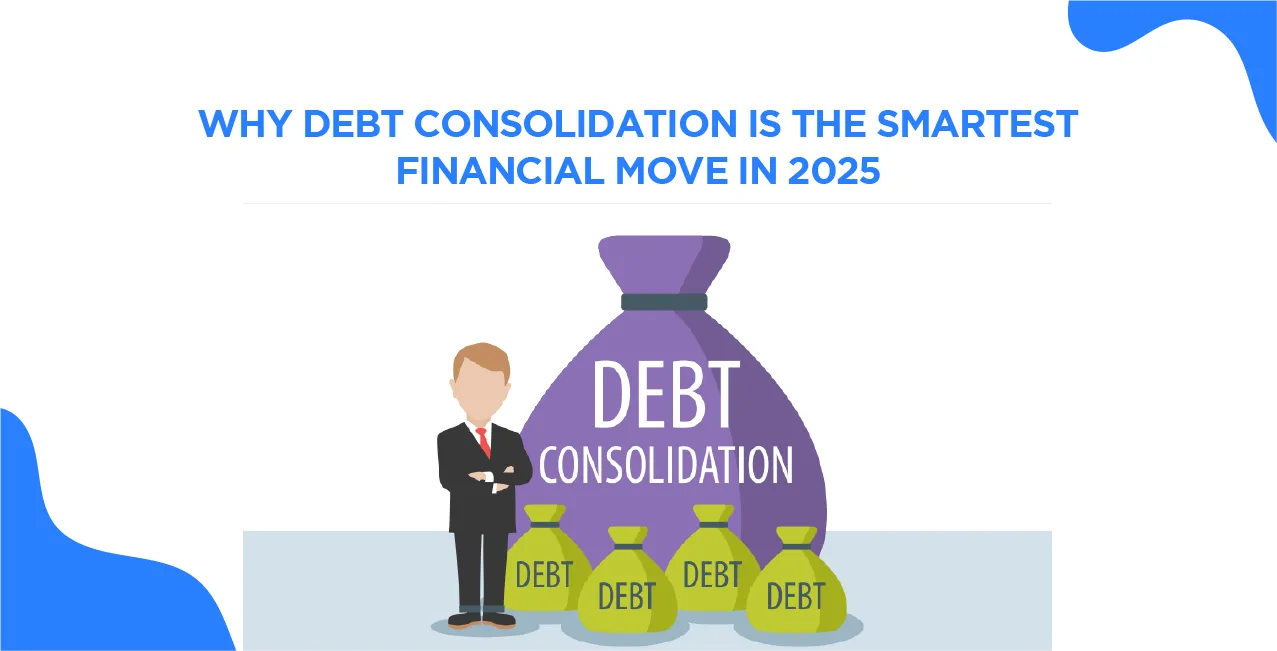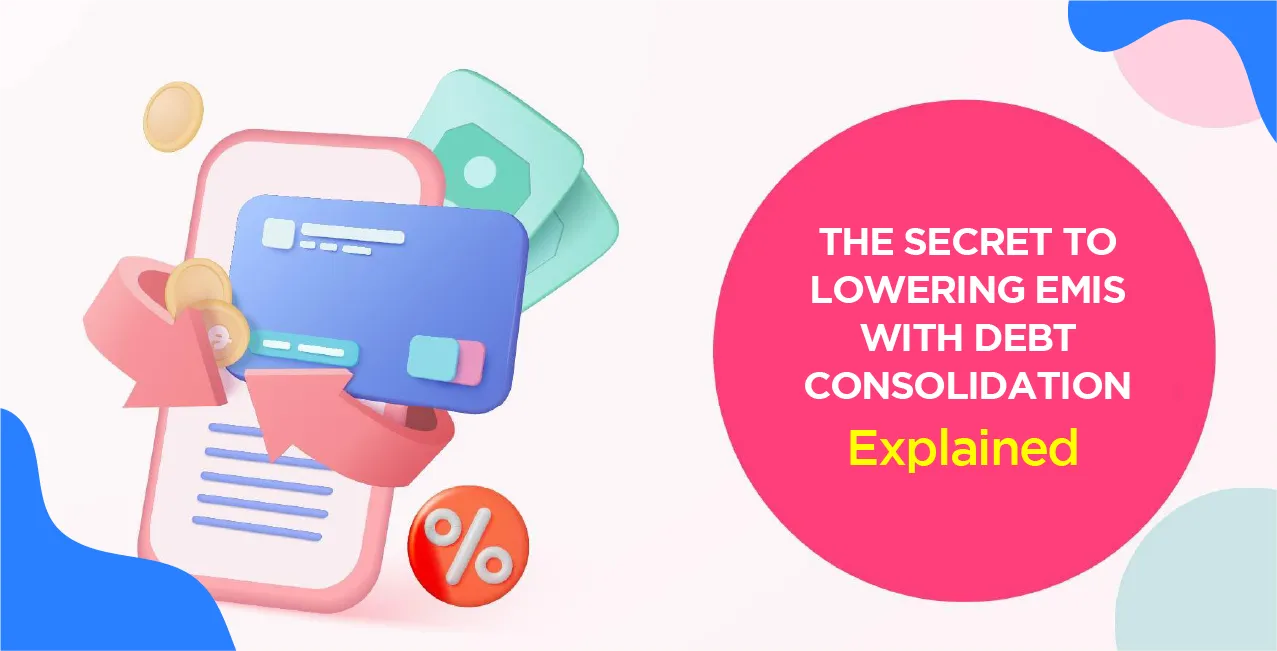
Author
LoansJagat Team
Read Time
10 Min
27 May 2025
10 Smart Ways to Use a Personal Loan to Build Wealth
Samay, a 25-year-old graphic designer, wanted to start his own business but did not have enough savings. He took a personal loan of ₹5,00,000 at 12% interest to buy a high-quality laptop (₹1,00,000), a printer (₹50,000), and invest in online ads (₹1,50,000). The rest (₹2,00,000) was kept aside for emergencies.
Within six months, his design business earned ₹40,000 per month. After paying his loan EMI of ₹11,000, he still had ₹29,000 as profit. In a year, his monthly income grew to ₹60,000, and he even hired an assistant. By repaying the loan on time, his credit score also improved.
Samay’s innovative use of a personal loan helped him turn his dream into a money-making reality. Want to know how you can do the same? Keep reading to learn 10 clever ways to use a personal loan to build wealth!
1. Debt Consolidation
Using a personal loan to consolidate debt is a smart way to manage your money better. If you have many debts with high interest rates, like credit cards or personal loans, you can take out a personal loan to pay them all off. This means you will have only one monthly payment, usually with a lower interest rate. It helps you save money and makes it easier to keep track of your payments.
Example: Before and After Debt Consolidation
Debt Type | Amount (₹) | Interest Rate | Monthly Payment (₹) |
Credit Card 1 | 50,000 | 36% | 2,000 |
Credit Card 2 | 30,000 | 30% | 1,200 |
Personal Loan | 20,000 | 24% | 800 |
Total Before | 1,00,000 | — | 4,000 |
New Personal Loan | 1,00,000 | 12% | 2,200 |
In this example, a person had three debts totaling ₹1,00,000 with high interest rates. By taking a new personal loan at 12% interest, he paid off all old debts. Now, he has only one monthly payment of ₹2,200 instead of ₹4,000. This saves ₹1,800 every month and makes managing money easier.
Read More – Should You Pay Off Debt or Invest First?
Debt consolidation can help you save money and reduce stress. But make sure you can afford the new loan payments before you decide.
2. Home Improvements
Using a personal loan for home improvements can be a smart way to increase your property's value. By upgrading key areas like the kitchen, bathroom, or exterior, you can make your home more appealing to buyers and potentially boost its resale price. This means that the money you spend on renovations could be returned to you, or even multiplied, when you sell your home.
Example: Home Improvement Investment and Return
Improvement Type | Cost (₹) | Estimated Value Increase (₹) | Return on Investment (ROI) |
Kitchen Remodel | 5,00,000 | 4,80,000 | 96% |
Bathroom Renovation | 3,00,000 | 2,20,000 | 73% |
Entry Door Replacement | 1,80,000 | 3,40,000 | 188% |
Garage Door Replacement | 3,70,000 | 7,20,000 | 194% |
Landscaping | 4,00,000 | 4,00,000 | 100% |
In this table, we see that certain improvements, like replacing the garage door or entry door, can offer a high return on investment. Landscaping also provides a full return, making it a worthwhile project. By choosing renovations with high ROI, you can effectively use a personal loan to enhance your home's value.
3. Starting or Expanding a Business
Using a personal loan to start or grow a small business can be a smart way to build wealth. It provides the funds needed for startup costs like equipment, inventory, and marketing. If the business does well, it can generate income that exceeds the loan payments, helping you earn more money over time.
Example: Starting a Small Cafe with a Personal Loan
Item | Cost (₹) |
Equipment (coffee machine, furniture) | 3,00,000 |
Initial Inventory (coffee beans, snacks) | 1,00,000 |
Rent Deposit | 1,50,000 |
Marketing and Branding | 50,000 |
Licenses and Permits | 30,000 |
Total Startup Cost | 6,30,000 |
Assuming a personal loan of ₹6,30,000 at 12% annual interest for 5 years:
- Monthly EMI: ₹14,000 (approximate)
If the cafe earns ₹50,000 per month after expenses:
- Monthly Profit After Loan Payment: ₹36,000
Over time, this profit can accumulate, helping you build wealth. It is important to have a solid business plan and ensure you can manage the loan repayments.
4. Education and Skill Development
Using a personal loan to finance education or skill development can be a smart investment in your future. By acquiring new qualifications or certifications, you can enhance your skills, increase your earning potential, and open up new career opportunities. This approach allows you to pay for courses upfront and gradually repay the loan as your income grows.
Example: Investing in a PMP (Project Management Professional) Certification
Expense Item | Cost (₹) |
PMP Training Course | 18,000 |
PMP Exam Fee | 42,863 |
Study Materials & Mock Tests | 6,003 |
Total Investment | 66,866 |
Assuming a personal loan of ₹66,866 at 12% annual interest for 2 years:
- Monthly EMI: Approximately ₹3,150
After obtaining the PMP certification, professionals in India can see significant salary increases. Mid-career professionals with PMP certifications often earn between ₹12,00,000 to ₹20,00,000 annually, compared to ₹6,00,000 to ₹9,00,000 for those without the certification.
By investing in such certifications, you not only enhance your skills but also position yourself for better job opportunities and higher income.
5. Medical Expenses
Using a personal loan to cover unexpected medical expenses can help you avoid high-interest debt and maintain financial stability. Medical emergencies often come without warning, and treatments can be expensive. By opting for a personal loan, you can spread the cost over time with manageable monthly payments, rather than depleting your savings or relying on high-interest credit cards.
Example: Managing Medical Expenses with a Personal Loan
Medical Procedure | Estimated Cost (₹) |
Heart Bypass Surgery | 3,00,000 – 5,00,000 |
Kidney Transplant | 5,00,000 – 7,00,000 |
Chemotherapy (per cycle) | 27,000 – 42,000 |
Knee Replacement | 3,00,000 – 4,50,000 |
Assuming a personal loan of ₹5,00,000 at an interest rate of 12% per annum for a tenure of 5 years:
- Monthly EMI: Approximately ₹11,122
By choosing a personal loan, you can ensure timely medical treatment without the burden of immediate full payment. This approach helps in managing finances effectively during challenging times.
6. Major Purchases
Using a personal loan for essential large purchases, like a reliable vehicle, can be a smart financial decision. It allows you to acquire necessary assets without depleting your savings, and the fixed repayment terms make budgeting easier.
Example: Aditya's Journey to Financial Independence
Aditya, a 28-year-old from Bengaluru, wanted to start a food delivery service. To do this, he needed a dependable scooter. He decided to take a personal loan to finance this purchase.
Item | Cost (₹) |
Scooter Purchase | 80,000 |
Insurance & Registration | 10,000 |
Safety Gear | 5,000 |
Total Investment | 95,000 |
Aditya took a personal loan of ₹95,000 at an interest rate of 12% per annum for a tenure of 3 years.
- Monthly EMI: Approximately ₹3,150
With his new scooter, Aditya started his delivery service, earning around ₹15,000 per month. After paying the EMI, he had ₹11,850 left, which he used for other expenses and savings.
By using a personal loan, Aditya was able to kickstart his business without financial strain, setting him on a path to financial independence.
7. Credit Score Improvement
Using a personal loan wisely can help improve your credit score, making it easier to get loans in the future. When you take a personal loan and pay it back on time every month, it shows banks that you are responsible with money. This can increase your CIBIL score, which is a number that tells lenders how trustworthy you are with credit.
Example: Improving Credit Score with a Personal Loan
Loan Details | Amount (₹) |
Personal Loan Amount | 1,00,000 |
Interest Rate | 12% per annum |
Loan Tenure | 12 months |
Monthly EMI | 8,885 |
Initial CIBIL Score | 650 |
CIBIL Score After 12 Months | 700 |
In this example, by taking a personal loan of ₹1,00,000 and paying the EMI of ₹8,885 on time every month for a year, the individual's CIBIL score improved from 650 to 700. A higher CIBIL score can help you get loans with lower interest rates and better terms in the future.
Remember, timely repayment is key to building a good credit history. Always ensure you can afford the monthly payments before taking a loan.
8. Emergency Fund Creation
Using a personal loan to build an emergency fund can provide immediate financial security, especially when unexpected expenses arise. This approach allows you to have a safety net without depleting your savings.
Example: Mahima's Emergency Fund Creation
Mahima, a 30-year-old software engineer in Bengaluru, realised the importance of having an emergency fund after witnessing her friend's struggle during a medical crisis. She decided to establish her emergency fund using a personal loan.
Details | Amount (₹) |
Personal Loan Amount | 3,00,000 |
Interest Rate | 12% per annum |
Loan Tenure | 3 years |
Monthly EMI | 9,958 |
Emergency Fund Target | 3,00,000 |
Mahima deposited the loan amount into a high-interest savings account, ensuring that the funds were readily available for emergencies. By doing so, she avoided the need to liquidate long-term investments or rely on high-interest credit cards during unforeseen situations.
While this strategy provides immediate access to emergency funds, it is essential to consider the interest payments on the loan. Therefore, it is advisable to use this method only when other options are unavailable.
9. Investment in Income-Generating Assets
Using a personal loan to invest in income-generating assets can be a strategic way to build wealth. By allocating borrowed funds to investments that yield regular returns, you can create additional income streams. However, it is essential to ensure that the returns from these investments exceed the cost of the loan, including interest payments.
Example: Investing in Rental Property with a Personal Loan
Investment Details | Amount (₹) |
Personal Loan Amount | 10,00,000 |
Interest Rate | 12% per annum |
Loan Tenure | 5 years |
Monthly EMI | 22,244 |
Annual EMI Payment | 2,66,928 |
Rental Property Purchase Price | 10,00,000 |
Expected Monthly Rental Income | 25,000 |
Annual Rental Income | 3,00,000 |
Annual Net Income (After EMI) | 33,072 |
In this scenario, an individual takes a personal loan of ₹10,00,000 at 12% interest for 5 years to purchase a rental property. The property generates a monthly rental income of ₹25,000, totaling ₹3,00,000 annually. After paying the annual EMI of ₹2,66,928, the individual retains a net income of ₹33,072 per year.
Also Read - How to Build Wealth While Paying Off Loans
This approach not only helps in acquiring an asset that appreciates over time but also provides a steady income stream. It is crucial to conduct thorough research and ensure that the investment's returns surpass the loan's cost to make this strategy effective.
10. Leveraging Opportunities
Using a personal loan to seize time-sensitive opportunities can be a strategic way to achieve financial growth. This approach allows you to act quickly on investments or ventures that require immediate funding. However, it is crucial to ensure that the returns from these opportunities exceed the cost of the loan, including interest payments.
Example: Investing in a Limited-Time Real Estate Deal
Details | Amount (₹) |
Personal Loan Amount | 5,00,000 |
Interest Rate | 12% per annum |
Loan Tenure | 3 years |
Monthly EMI | 17,500 |
Investment Opportunity | 5,50,000 |
Expected Return | 7,00,000 |
Net Profit | 1,50,000 |
In this scenario, an individual takes a personal loan of ₹5,00,000 at 12% interest for 3 years to invest in a limited-time real estate opportunity. The investment requires ₹5,50,000 and is expected to yield ₹7,00,000 upon sale. After repaying the loan, the individual nets a profit of ₹1,50,000.
This approach demonstrates how leveraging a personal loan for time-sensitive opportunities can result in financial gain. However, it is essential to conduct thorough research and ensure that the investment's returns exceed the loan's cost.
Conclusion
Taking a personal loan can be a smart way to manage your money if used wisely. It can help you pay off high-interest debts, improve your home, start a business, or even cover medical emergencies. By consolidating debts, you can save money on interest and make payments easier. Using a loan for education or skills can boost your income in the future.
Personal loans can also help in emergencies or big purchases like a work vehicle. If you repay the loan on time, it can even improve your credit score, making it easier to get loans later. However, it is important to plan carefully and make sure you can afford the monthly payments. Always compare interest rates and terms before borrowing.
A personal loan can be a useful tool, but only if you use it for the right reasons and manage it responsibly. Think about your needs and repayment ability before taking a loan to avoid financial stress.
FAQs
1. What is a personal loan?
A personal loan is money you borrow from a bank or lender for any personal need. You pay it back in monthly installments with interest over a fixed time.
2. When should I take a personal loan?
Take a personal loan for important needs like debt consolidation, medical bills, or education. Avoid using it for unnecessary expenses to prevent debt trouble.
3. How does a personal loan affect my credit score?
If you repay on time, it improves your credit score by showing responsible borrowing. Missing payments can hurt your score and make future loans harder to get.
4. What is the interest rate on a personal loan?
Interest rates vary but usually range from 10% to 24% per year. Your rate depends on your credit score, income, and the lender’s terms.
5. Can I prepay a personal loan?
Yes, most banks allow prepayment but may charge a small fee. Paying early saves interest, so check your lender’s rules before doing so.
About the Author

LoansJagat Team
‘Simplify Finance for Everyone.’ This is the common goal of our team, as we try to explain any topic with relatable examples. From personal to business finance, managing EMIs to becoming debt-free, we do extensive research on each and every parameter, so you don’t have to. Scroll up and have a look at what 15+ years of experience in the BFSI sector looks like.

Quick Apply Loan
Subscribe Now
Related Blog Post


